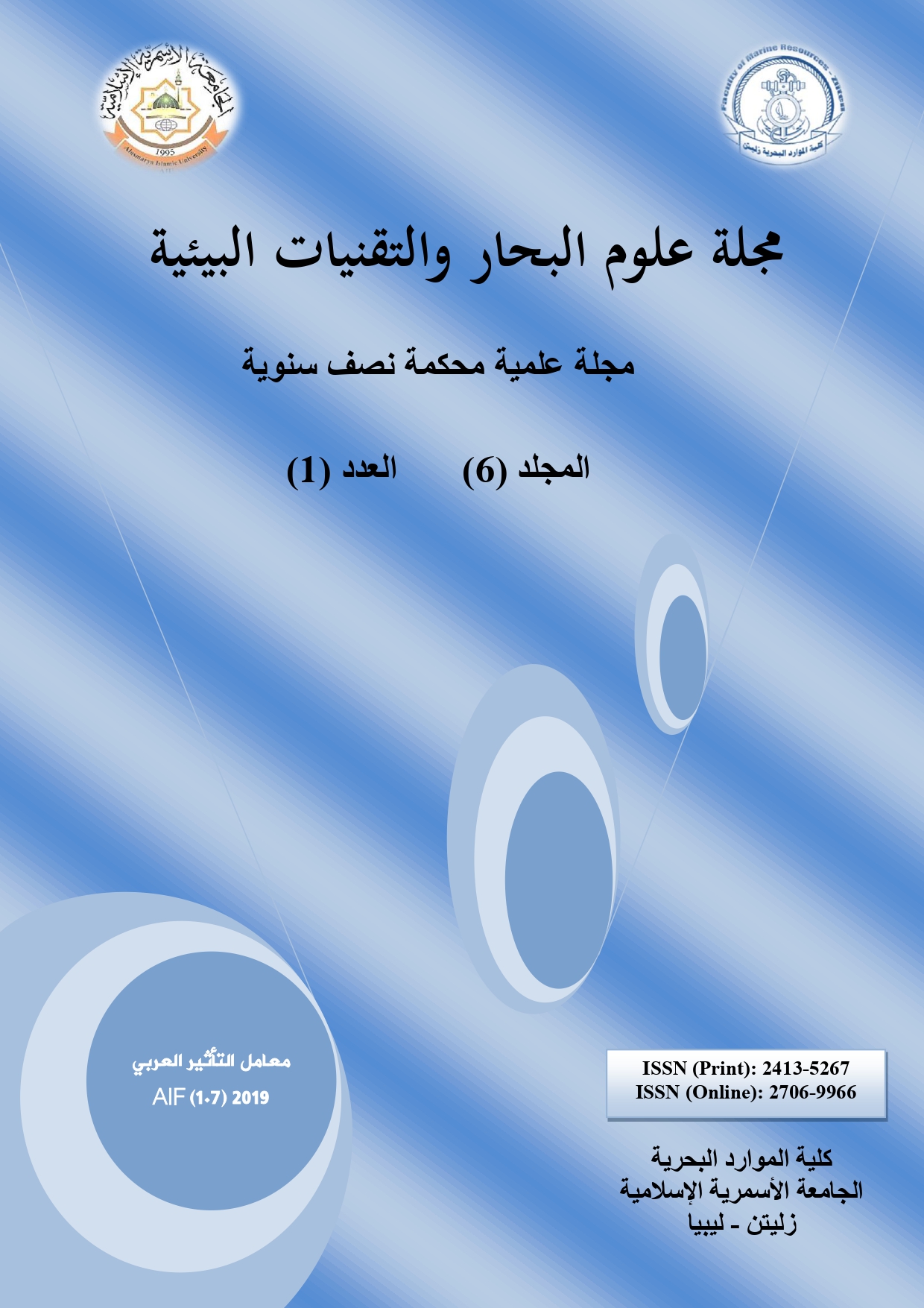معالجة ميـــــاه الصرف الناتجة من الصناعـات البتروكيماوية: المفهوم والتقنيات الحالية - مراجعـــــة
DOI:
https://doi.org/10.59743/jmset.v6i1.49الكلمات المفتاحية:
المعالجة الفيزيائية، الأكسجين اللازم لعمليات المعالجة، المعالجة الكيميائيةالملخص
يتطلب التزايد المستمر على الطاقة مزيدا من الاستكشاف واستغلال للموارد الطبيعية والتي تشمل النفط الخام المسئول الأول عن التلوث حيث أدى زيادة استهلاك النفط والصناعات البتروكيميائية (PRE) الناتجة عنه في المجتمع الحديث إلى توليد المزيد من نفايات مصافي النفط. تحتوي المياه العادمــة الناتجة عن هذه الصناعات بشكل أساسي على المواد العضوية والمركبات الخطيرة الأخرى كالنفايات والتي تحتاج إلى إدارة جيدة قبل أن يتم تصريفها إلى أي مياه غير ضارة بالوسط البيئي. يمكن إجراء المعالجة لهذه المياه العادمة من خلال عمليات المعالجة الفيزيائية والبيولوجية والكيميائية. تنقسم معالجة المياه العادمة البترولية او الناتجة عن هذه الصناعات الى مرحلتين: أولاً: مرحلة ما قبل المعالجة لتقليل الشحوم والزيوت والمواد العالقــــة، وثانيــاً: مرحلة المعالجة المتقدمة لتخفيض الملوثات وتقليلها إلى قيم تصريف مقبولة. تلخص هذه الورقة بشكل علمي مختصر الدراسات والبحوث التي أجريت في هذا الصدد وكذلك النتائج التي تم التوصل اليها.
المراجع
Al Hashemi W., Maraqa M.A., Rao M.V., and Hossain M.M. (2015). Characterization and removal of phenolic compounds from condensate-oil refinery wastewater. Des. Water Treat., 54(3): 660-671.
Aljuboury D.D.A., Palaniandy P., Abdul Aziz H.B., and Feroz S. (2015). Treatment of petroleum wastewater using combination of solar photo-two catalyst TiO2 and photo-Fenton process. J. Environ. Chem. Eng., 3(2): 1117-1124.
Altaş L., and Büyükgüngör H. (2008). Sulfide removal in petroleum refinery wastewater by chemical precipitation. J. Hazard Mater., 153(1-2): 462-469.
Asatekin A., and Mayes A.M. (2009). Oil Industry wastewater treatment with fouling resistant membranes containing amphiphilic comb copolymers. Environ. Sci. Tech., 43(12): 4487-4492.
Attiogbe F.K., Glover-Amengor M., and Nyadziehe K.T. (2007). Correlating biochemical and chemical oxygen demand of effluents, a case study of selected industries in Kumasi, Ghana. W. Afr. J. Appl. Ecol., 11(1): 110-118.
Benyahia F. (2006). Refinery wastewater treatment: a true technological challenge. 7th Annual U.A.E. University Res. Confer, 186-194.
Coelho A., Castro A.V., Dezotti M., and Anna G.Jr.L.S. (2006). Treatment of petroleum refinery sourwater by advanced oxidation processes. J. Hazard Mater. B, 137(1): 178-184.
Diya’uddeen B.H., Wan M.A., Wan D., and Abdul Aziz A.R. (2011). Treatment technologies for petroleum refinery effluents: A review. Process Saf. Environ. Protec., 89(2): 95-105.
El-Naas M.H., Al-Zuhair S., Al-Lobaney A., and Makhlouf S. (2009). Assessment of electro-coagulation for the treatment of petroleum refinery wastewater. J. Environ. Manage., 91(1): 180-185.
Farajnezhad H., and Gharbani P. (2012). Coagulation treatment of wastewater in petroleum industry using poly aluminum chloride and ferric chloride. Inter. J. Res. Review. Appl. Sci., 13(1): 306-310.
Gasim H.A., Kutty S.R.M., Hasnain-Isa M., and Alemu L.T. (2013). Optimization of anaerobic treatment of petroleum refinery wastewater using artificial neural networks. Res. J. Appl. Sci. Eng. Tech., 6(11): 2077-2082.
Harry M.F. (1995). Industrial Pollution Handbook. McGraw Hill Inc., New York, USA.
Kriipsalu M., Marques M., Nammari D. R., and Hogland W. (2007). Bio-treatment of oily sludge: The contribution of amendment material to the content of target contaminants, and the biodegradation dynamics. J. Hazard. Mater., 148(3): 616-622.
Lorenc-Grabowska E., and Gryglewicz G. (2007). Adsorption characteristics of Congo Red on coal-based mesoporous activated carbon. Dyes and pigments, 74(1): 34-40.
Lawrence K., Wang Yung-Tse Hung, Howard H., and Lo Y.C. (2007). Hazardous industrial waste treatment. Taylor and Francis. New York, USA.
Ma F., Guo J.B., Zhao L.J., Chang C.C., and Cui D. (2009). Application of bio-augmentation to improve the activate sludge system into the contact oxidation system treatment petrochemical wastewater. Bioresource Tech., 100(2): 597-602.
Nasirpour N., Mousavi S., and Shojaosadati S. (2015). Biodegradation potential of hydrocarbons in petroleum refinery effluents using a continuous anaerobic-aerobic hybrid system. Korean J. Chem. Eng., 32(5): 874-881.
Sancey B., Badot P.M., and Crini G. (2009). Chitosan for coagulation/flocculation processes–An eco-friendly approach/F. Eur. Polym. J., 45: 1337-1348.
Renou S., Givaudan J.G., Poulain S., Dirassouyan F., and Moulin P. (2008). Landfill leachate treatment: review and opportunity. J. Hazard. Mater., 150(3): 468-493.
Satyawali Y., and Balakrishnan M. (2008). Wastewater treatment in molasses-based alcohol distilleries for COD and color removal: a review. J. Environ. Manage., 86(3): 481-497.
Sirianuntapiboon S., and Ungkaprasatcha O. (2007). Removal of Pb2+ and Ni2+ by bio-sludge in sequencing batch reactor (SBR) and granular activated carbon-SBR (GAC-SBR) systems. Bio. Tech., 98(14): 2749-2757.
Squillance P.J., Zogorski J.S., Wilber W.G., and Price C.V. (1996). Preliminary assessment of the occurrence and possible sources of MTBE in groundwater in the United States. Environ. Sci. Technol., 30(5): 1721-1730
Vendramel S., Bassin J.P., Dezotti M., and Sant’ Anna Jr G.L. (2015). Treatment of petroleum refinery wastewater containing heavily polluting substances in an aerobic submerged fixed-bed reactor. Environ. Tech., 36(16): 2052-205.
Wake H. (2005). Oil refineries: a review of their ecological impacts on the aquatic environment. Estuar. Coast Shelf Sci., 62(1-2): 131-140.
Wang B., Yi W., Yingxin G., Guomao Z., Min Y., Song W., and Jianying H. (2015). Occurrences and behaviors of Naphthenic Acids in a petroleum refinery wastewater treatment plant. Environ. Sci. Technol., 49(9): 5796-5804.
Wang Y., Wang Q., Min L, Yingnan Y., Wei H., Guangxu Y., and Shaohui G. (2016). An alternative anaerobic treatment process for treatment of heavy oil refinery wastewater containing polar organics. Biochem. Eng. J., 105: 44-51.
Zhao X., Wang Y., Ye Z., Borthwick A.G.L., and Ni J. (2006). Oil field wastewater treatment in Biological Aerated Filter by immobilized microorganisms. Process Biochem., 41(7): 1475–1483.
Zou X.L. (2015). Treatment of heavy oil wastewater by UASB–BAFs using the combination of yeast and bacteria. Environ, Tech., 36(18): 2381-2389.
التنزيلات
منشور
إصدار
القسم
الرخصة
الحقوق الفكرية (c) 2020 مجلة علوم البحار والتقنيات البيئية

هذا العمل مرخص بموجب Creative Commons Attribution 4.0 International License.









